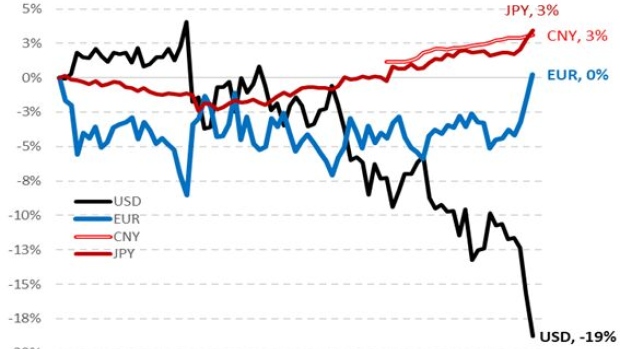Apr 18, 2023
De-Dollarization Is Happening at a ‘Stunning’ Pace, Jen Says
, Bloomberg News

(Bloomberg) -- The dollar is losing its reserve status at a faster pace than generally accepted as many analysts have failed to account for last year’s wild exchange rate moves, according to Stephen Jen.
The greenback’s share in global reserves slid last year at 10 times the average speed of the past two decades as a number of countries looked for alternatives after Russia’s invasion of Ukraine triggered sanctions, Jen and his Eurizon SLJ Capital Ltd. colleague Joana Freire wrote in a note. Adjusting for exchange rate movements, the dollar has lost about 11% of its market share since 2016 and double that amount since 2008, they said.
“The dollar suffered a stunning collapse in 2022 in its market share as a reserve currency, presumably due to its muscular use of sanctions,” Jen and Freire wrote. “Exceptional actions taken by the US and its allies against Russia have startled large reserve-holding countries,” most of which are emerging economies from the so-called Global South, they said.
Jen is the former Morgan Stanley currency guru who coined the dollar smile theory.
Last year, Bloomberg’s gauge of the greenback surged as much as 16% as the conflict helped fuel a rise in global inflation that triggered widespread interest rate hikes which sank bond and currency markets alike. It finished the year up 6%.
Biden’s Dollar Weaponization Supercharges Hunt for Alternatives
Smaller nations are experimenting with de-dollarization while China and India are pushing to internationalize their currencies for trade settlement after the US and Europe cut Russian banks from the global financial messaging system known as SWIFT. There’s also concern the dollar may become a permanent political tool, or be used as a form of economic statecraft to put extra pressure on countries to enforce sanctions that they may disagree with.
The US currency now represents about 58% of total global official reserves, down from 73% in 2001 when it was the “indisputable hegemonic reserve,” the Eurizon pair said.
That said, the dollar’s role as an international currency won’t be challenged anytime soon as developing countries don’t yet have the ability to divest from the greenback for transactions due to its large, liquid and well-functioning financial markets, Jen and Freire wrote.
Still, the persistence of those conditions “is not preordained” and there may come a time when the rest of the world actively avoids using the dollar, they wrote.
“The prevailing view of ‘nothing-to-see-here’ on the US dollar as a reserve currency seems too innocuous and complacent,” the two wrote. “What needs to be appreciated by investors is that, while the Global South is unable to totally avoid using the dollar, much of it has already become unwilling to do so.”
©2023 Bloomberg L.P.






